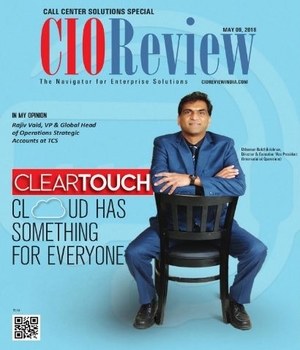
Contact Center - Trends and Opportunities
Supantha Banerjee, CIO, PSC Metals, Inc. | Tuesday, 29 March 2016, 12:56 IST
 Gone are the days when a customer service call started with, “what is your order number?” If John Doe calls, now conversation starts with “Thank you Mr. Doe for being a loyal customer. Wish you a belated happy birthday. I see that you bought a TV from us last month, how is that working out for you. How can I help you today?” The concept of customer service and contact center communication channels have evolved in leaps and bounds over the past decade and so did associated applications/infrastructure technologies to support this tremendous transformation.
Gone are the days when a customer service call started with, “what is your order number?” If John Doe calls, now conversation starts with “Thank you Mr. Doe for being a loyal customer. Wish you a belated happy birthday. I see that you bought a TV from us last month, how is that working out for you. How can I help you today?” The concept of customer service and contact center communication channels have evolved in leaps and bounds over the past decade and so did associated applications/infrastructure technologies to support this tremendous transformation.
As the share of baby boomers, in population, goes down, and gen X, gen Y, and gen Z increases, we see a disruptive change in the way we communicate. The number of phone calls in the corporate world is decreasing and so are in-person meetings. Face-to-face human interactions are being replaced by email, instant message, and text. It is said that more than 50 percent of communication is attributed to body language; was that ever really true? If it was, it does not seem to apply to the millennial and the gen Zs. Today’s youth prefers text, email, web chat, and instant message over phone or in-person conversations. Cell phone was invented to address the challenge of not being able to communicate while away from a land line phone; however the cell phone has now turned into a computing device that aggregates different communication channels, social media services, games, and many other applications. This trend will continue and technology will continue to evolve to support these needs without compromise.
Following are key trends and opportunities in contact center business and technology space.
1. Paradigm Shift on the Notion of “Customer Service” And “Call Center”:
Organizations have started to promote that customer service is not a department but a culture. Teams such as contact center and shop floor associates, which come in contact with customers directly or indirectly, can truly make significant impact on top-line. Some organizations have redefined their customer service organization as client service organization to focus more on repeat business opposed to one time transactional deals.
With customer service requests being received via channels not limited to phone calls, it is more appropriate to address client service center or call center as “Contact Center”. Contact center is not only limited to providing back end after sales support but is also being leveraged to increase sales, increase consumer/customer awareness, and promote “magic selling”.
2. Modernization of Contact Center Technology Infrastructure:
Increased focus on customer service, online presence, eCommerce, and omnichannel drove many organizations to review their existing contact center technology infrastructure and application portfolio. Is infrastructure modern enough to support omnichannel and millennial needs? Does it have scalability to perform at expected service levels during high volume sale seasons? Does it have business continuity and disaster recovery plan for contact center operations? Customers now come in contact with contact center via email, live agent chat, and phone calls. It is only a matter of time before companies would start offering these services via text messages.
Below are some of the salient improvements organizations are making to address these challenges.
(1) System of record and master data is being enhanced to include multiple phone numbers and email addresses of a customer so that the customer is identified as soon as the call is placed.
(2) Traditional IVR systems are being modernized or re-architected to keep only call routing functionality in legacy technology and a business layer is being developed in modern technologies to be positioned for faster time to market.
(3) Contact center applications are being redesigned to interface with system of record, master data, eCommerce, and social media on a real-time basis.
(4) A combination of artificial intelligence and predictive analytics is being utilized to help route calls to appropriate contact center agent and load balance workload.
(5) Industry specific compliances and regulations are also driving system changes focused towards how sensitive data such as credit card information, driver’s license information, medical information, audio recording of customer conversation, and other data is stored.
(6) All of these are being supported by small to large scale data warehouses for real time performance monitoring, work load balancing, management oversight, and decision making. Advanced analytics on call type, call volume, customer demography, call location, and other information provides a huge lift to marketing efforts and helps in deciding test markets for new products /services.
In the IT Infrastructure Space,
(1) Traditional PBXs are being replaced by hosted PBX for improved functionality, additional features, lesser cost of ownership, improved administration and management, and faster development.
(2) Traditional phone sets are being replaced by softphones reducing hardware expense and improving call quality and POTS lines are being replaced by VOIP. Lucrative new offerings such as cloud subscription model, cloud consumption models that seem to make strong short term business case may however prove otherwise if long term outlook is overlooked. Recent cyber-attacks against big businesses have moved security vs. usability, hosted vs. on-premises, private vs. public considerations to the top of the list of CIO priorities.
3. Empowered customer service representatives:
Companies invest millions of dollars to train new contact center agents. Cost of training seasonal employees is significantly higher in retail industry. Innovation in this space has been to empower contact center agents, reduce training expenses, and predict and push agents with information about next best action or step to perform their job with ease and without the need for extensive onboarding and training programs. Custom developed agent screens now integrate relevant information from POS, ERP, eCommerce, and CRM systems.
Companies are rethinking contact center application interfaces to see how number of clicks, scrolling, and other movements can be reduced to make order entry and return processes faster and improve customer experience. These applications are being made smarter to collect data for advance analytics (customer name, address; why the customer might be calling; what the customer bought in past one year; when is the customer’s marriage anniversary/birthday etc.) and present customer information to an agent before a call/conversation is initiated with an agent. Modern call center applications integrate live chat, email, and softphone systems effectively without cluttering user interfaces and help agents work smarter. Over next 5-10 years, contact center will augment traditional and online point of sales systems and organizations will leverage contact center to push new product, increase customer awareness of new/existing products. This will transform contact center into a revenue generation channel.
4. Following the Sun:
With advent of technologies such as Virtual Desktop, and hosted PBX, coupled with more affordable cloud offerings, organizations have started to leverage BPO services more than ever before. These technologies have addressed challenges associated with remote worker, bandwidth usage, and call quality to some extent. In addition, it has helped organizations maintain their OpEx in a more manageable level while having 24x7 availability of contact center staff. With BYOD and hosted PBX, contact center personnel can work from any corner of the world and still stay connected. As world gets smaller and flatter, preferred contact center offshore locations will move from country to country and a scalable IT infrastructure makes these moves relatively painless.
It is imperative that organizations continuously improve business processes and leverage technology to improve customer experience. However, it is not just about enhanced customer experience but also about enhanced agent experience. In job functions such as customer services where turnover rate is high, user friendly systems, and agent empowerment can help reduce agent stress and improve retention. In summary, good contact center systems are those that empower agents, enhance customer experience, and elevate performance of the business function. At the end of the day, a good system is only as good as the employees who use, maintain, and upgrade it. Is your workforce agile and futuristic? Does your workforce want to lead change? Do your employees want to be changed?
CIO Viewpoint
Leveraging Innovations in Technology: Key for...
By Bill Kloster, CIO, SEH
By Milan Kumar, Global CIO, WABCO
Customer Centricity By Design: Engineering The...
By Scott Alcott, CIO, Comcast Cable [NASDAQ: CMCSA]
CXO Insights
Tips on how Conversational Service can provide...
By By Umesh Sachdev, co-founder and CEO, Uniphore
New Paradigm-Intelligent Manufacturing
By Santosh Kotnis, EVP & CEO (Managed Infrastructure and Digital Transformation Solutions), Futurism Technologies
Enhanced Focus on Cybersecurity in the Digital...


.jpg)

.jpg)
.jpg)




